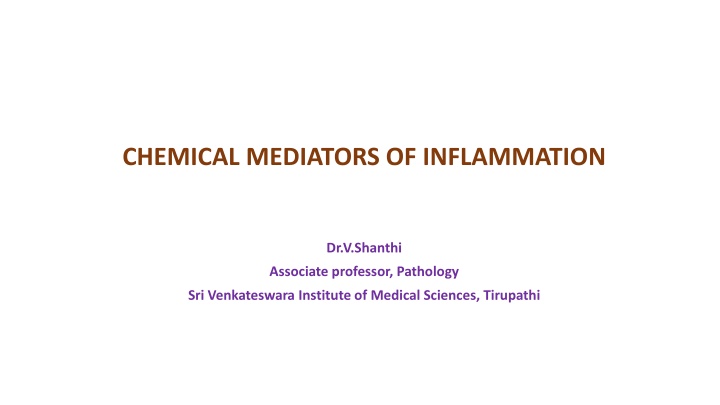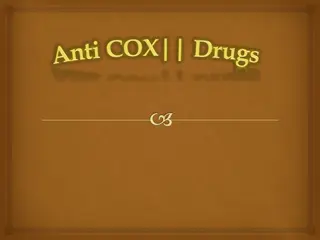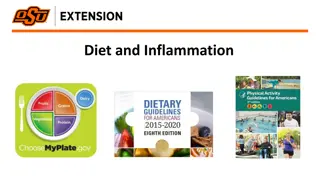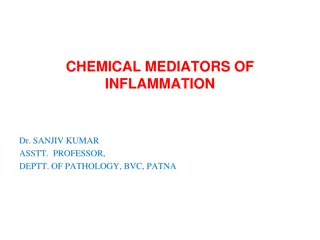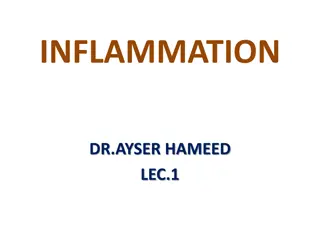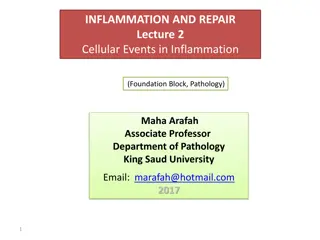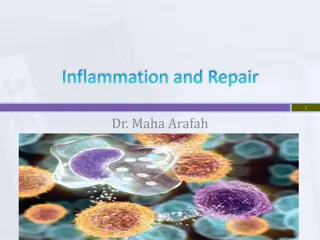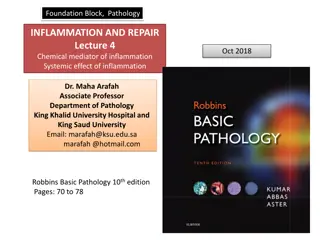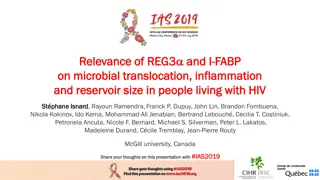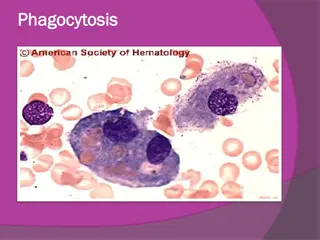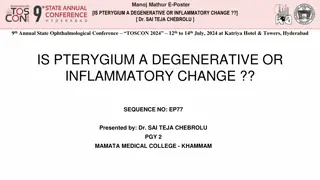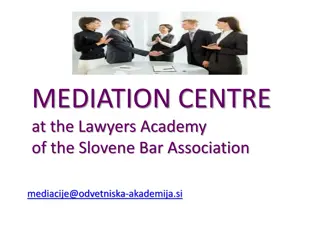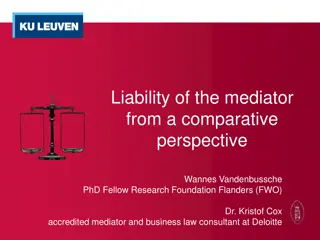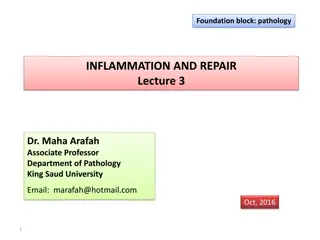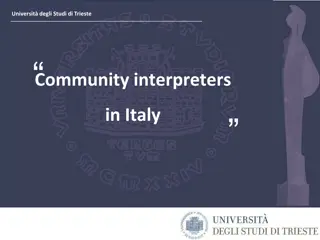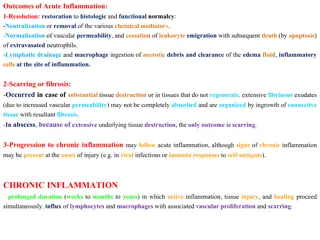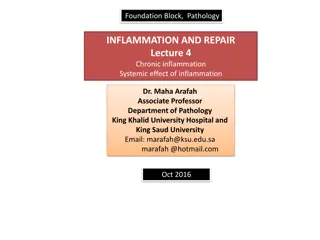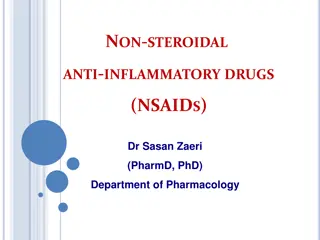CHEMICAL MEDIATORS OF INFLAMMATION
Delve into the roles of various chemical mediators in inflammation with Dr. V. Shanthi, an Associate Professor of Pathology at Sri Venkateswara Institute of Medical Sciences in Tirupathi. Explore the mechanisms and impacts of these mediators on the body's inflammatory response. Gain insights into the latest research and developments in this crucial area of study.
Download Presentation

Please find below an Image/Link to download the presentation.
The content on the website is provided AS IS for your information and personal use only. It may not be sold, licensed, or shared on other websites without obtaining consent from the author.If you encounter any issues during the download, it is possible that the publisher has removed the file from their server.
You are allowed to download the files provided on this website for personal or commercial use, subject to the condition that they are used lawfully. All files are the property of their respective owners.
The content on the website is provided AS IS for your information and personal use only. It may not be sold, licensed, or shared on other websites without obtaining consent from the author.
E N D
Presentation Transcript
CHEMICAL MEDIATORS OF INFLAMMATION Dr.V.Shanthi Associate professor, Pathology Sri Venkateswara Institute of Medical Sciences, Tirupathi
CHEMICAL MEDIATORS Inflammatory mediators are the substances that initiate and regulate inflammatory reactions Mediators originate from either Plasma - These are present in precursor forms that must be activated by series of proteolytic cleavage to acquire biologic properties e.g. complement proteins & kinins Cells present in intracellular granules that need to be secreted (e.g. Histamine in mast cells) or synthesized denovo in response to stimulus (e.g. Prostaglandins, cytokines)
CHEMICAL MEDIATORS Mediators perform activity by Mostly by binding to receptors on target cells Direct enzymatic activity e.g. Lysosomal proteases Mediate oxidative damage e.g. reactive oxygen species & nitrogen intermediates Mediators can act on One or few target cells Can have diverse targets Have different effect on different cell types
CHEMICAL MEDIATORS Once activated & released from the cell the mediators are short lived. They either Quickly decay e.g. Arachidonic acid metabolites Inactivated by enzymes e.g. kininase inactivates Bradykinin Scavenged e.g. antioxidants scavenge toxic oxygen metabolites Inhibited e.g. complement regulatory proteins breakup & degrade activated complement components
CHEMICAL MEDIATORS Vasoactive amines First mediators to be released during inflammation are - Histamine Serotonin
CHEMICAL MEDIATORS HISTAMINE Richest source mast cells - also in platelets & Basophils Stimuli for degranulation of Mast cells Physical injury such as trauma , cold or heat Immune reactions involving binding of antibodies to Mast cells Fragments of complement called Anaphylotoxins (C3a & C5a ) Neuropeptides (substance P ) Cytokines (IL 1 & IL 8 )
CHEMICAL MEDIATORS HISTAMINE Action of Histamine Dilation of arterioles ( but constriction of large arterioles ) Increased permeability of veinules Principle mediator of immediate transient phase of increased vascular permeability Acts on microcirculation mainly via binding to H1 receptor on endothelial cells
CHEMICAL MEDIATORS SEROTONIN Action similar to that Histamine Source platelets & Enterochromaffin cells Release from platelets occurs when platelets aggregate after contact with Collagen Thrombin ADP Ag- Ab complexes
CHEMICAL MEDIATORS PLASMA PROTEINS Plasma proteins that mediate inflammatory response belong to 3 interrelated systems Complement system Kinin system Clotting systems
CHEMICAL MEDIATORS COMPLEMENT SYSTEM Complement system consists of 20 component proteins that are found in greatest concentration in plasma Complement components causes Increasing vascular permeability Chemotaxis Opsonisation
CHEMICAL MEDIATORS Complement system The early steps in complement activation consists of 3 pathways i.e. Classical pathway Alternate pathway Lectin pathway
CHEMICAL MEDIATORS COMPLEMENT SYSTEM Activation of complement cascade consists of 2 steps i.e. early step & late step Early steps consists of 3 different pathways & lead to proteolytic cleavage of C3 Late steps all 3 pathways converge & major breakdown products of C3, C3b activate a series of other complement components
CHEMICAL MEDIATORS - PLASMA PROTEINS classical pathway Ag-Ab complex Activated C1 C1 Classical pathway C3 convertase C3 C4b2b C4+C2 Recruitment and activation of leukocytes C3b C3a C4b2b3b Classical pathway C5 convertase
CHEMICAL MEDIATORS- PLASMA PROTEINS Alternate pathway Alternate pathway C5 convertase Recruitment and activation of leukocytes C3bBb3b C3 C3b C3a C3b Factor B Factor D C3bBb C3 Alternate pathway C3 convetase C3b +microbial polysaccharide
CHEMICAL MEDIATORS- PLASMA PROTEINS LECTIN PATHWAY C1 Activated C1 C3 convertase C4+C2 C3 C4b2b Recruitment and activation of leukocytes C3b C3a C4b2b3b C5 convertase
CHEMICAL MEDIATORS- PLASMA PROTEINS LATE PATHWAY Classical & Lectin pathway C5 convertase Recruitment and activation of leukocytes C4b2b3b C5a C5 C6 C7 C9 C8 Lysis of microbes C5 - 9 C5b C3bBb3b Membrane attack complex Alternate pathway C5 convertase
CHEMICAL MEDIATORS OF INFLAMMATION PLASMA PROTEINS The biologic function of complement system Cell lysis by MAC Vascular phenomenon increased vascular permeability & vasodilatation Leukocyte adhesion, chemotaxis & activation Phagocytosis
CHEMICAL MEDIATORS OF INFLAMMATION PLASMA PROTEINS Regulation of complement activation Regulation of C3 & C5 convertase by enhancing dissociation of convertase complex e.g. Decay accelerating factor Factor H causes cleavage of C3b and turnover of C3 convertase Binding of active complement components by specific proteins in plasma C1 inhibitor interferes with enzymatic activity of C1 Proteins that inhibit MAC formation e.g. CD59 inhibit excessive complement activation
CHEMICAL MEDIATORS OF INFLAMMATION PLASMA PROTEINS Disorders of complement system Deficiency of complement components lead to increased susceptibility to infections Deficiency of C4 & C2 autoimmune diseases e.g. SLE Genetic defeciency of complementary regulatory protein significant disease e.g. Paroxysmal Nocturnal Hemoglobinuria Deficiency of C1 inhibitor Hereditary angioneurotic edema
CHEMICAL MEDIATORS kinin system FACTOR XII Collagen, Basement membrane, and activated platelets HMWK FACTOR XIIa Kinin cascade Clotting cascade XIIa Kallikrein Prekallikrein Fibrinolytic system Increased vascular permeability Causes smooth muscle contraction Dilation of blood vessels Pain High molecular weight kininogen Bradykinin
CHEMICAL MEDIATORS Clotting system XIIa Factor XI Factor XIa Factor X Factor Xa Protease activated receptors ACUTE Thrombin Prothrombin INFLAMMATION Factor IIa Factor II
CHEMICAL MEDIATORS OF INFLAMMATION Clotting system Protease activated receptors These are 7- Transmembrane G protein receptors present on platelets, endothelial cells, smooth muscle cells, etc. Engagement of PAR by proteases particularly Thrombin triggers several responses like- Mobilization of P- selectin Production of chemokines Expression of endothelial adhesion molecule Production of Prostaglandins, PAF, & NO Changes in endothelial shape
CHEMICAL MEDIATORS Clotting system Kallikrein Thrombin Fibrin Fibrinogen Plasminogen Plasmin Fibrin split products Fibrinopeptides C3a C3 Complement cascade
